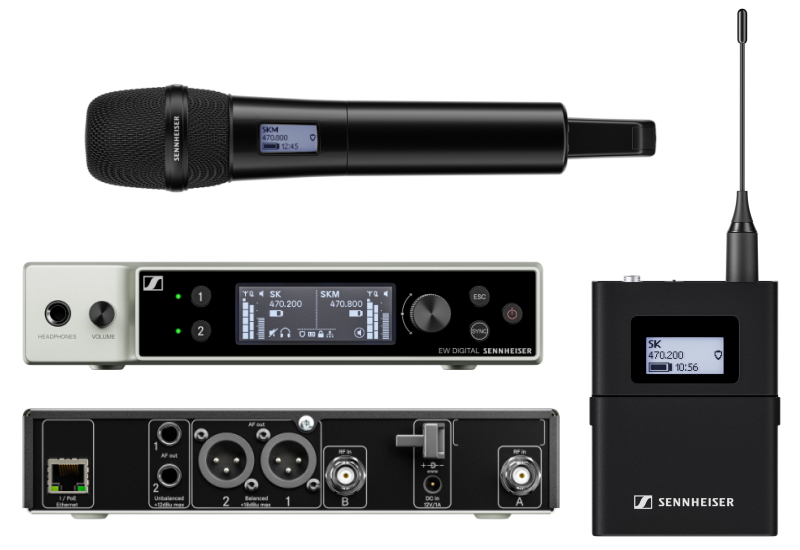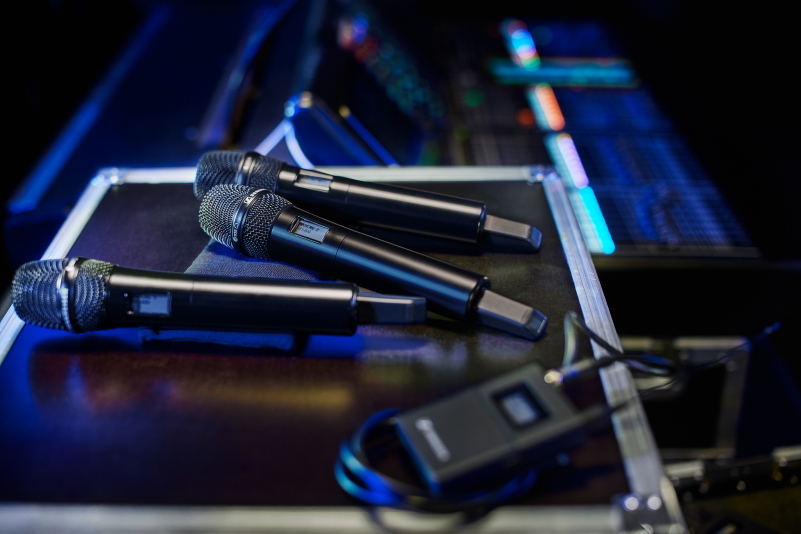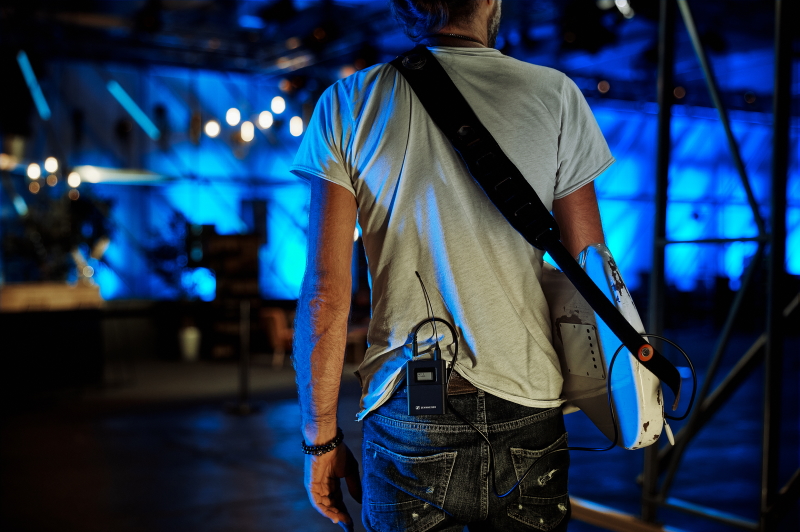Sennheiser EW-DX

Sennheiser has announced that the first EW-DX devices are shipping in North America, EMEA, Japan, and Singapore. Available products include the EW-DX EM 2 two-channel receiver, the handheld transmitter – with or without programmable mute switch – and the bodypack transmitter. The latter also comes in two versions, either with a special 3-pin mic connector or a 3.5 mm (1/8”) jack for mics or instrument cables. Convenient set packages are available, too, with further, higher frequency variants ready in Q1 2023, and more EW-DX devices and software being added to the line in mid-2023.
“This awesome system combines pro features and ease of use in well-designed, rugged housings. We’re happy to see it hitting the market,” says Benny Franke, product manager at Sennheiser. “EW-DX is a more than a worthy technological successor to the evolution wireless G4 series and will be setting a new standard in the live audio industry for simplicity, reliability, audio quality and frequency efficiency.”
Whether for rental companies, touring bands, theatres, worship or broadcasting – EW-DX will simplify workflows and bring an exciting feature set to any application. Like its EW-D sister models, EW-DX offers the lowest latency on the market (1.9 milliseconds), eliminates the need for frequency calculation, and offers an ultra-wide input dynamic range of 134 dB, enabling your transmitters to handle any signal that is thrown at them. Their operating time is 12 hours with the BA 70 rechargeable battery, which will usually take you through rehearsals and the show or event itself. Operating time with standard AA batteries amounts to eight hours. Depending on the RF environment, the transmitters have a range of up to around 100 m, enough even for very generous stage layouts.
EW-DX systems additionally benefit from an automatic multi-channel RF set-up, scalable remote control and monitoring, as well as AES-256 encryption for secure transmission of contents. The bandwidth is higher than with EW-D, up to 88 MHz, enabling more channels to be accommodated. As part of the Evolution Wireless Digital family, EW-DX is respectful towards the valuable resource that is the RF spectrum – and takes the complexities out of wireless at the same time. Carefully engineered, the systems do not generate any significant intermodulation products. From a spectrum efficiency point of view, this means that the microphones do not pollute the available spectrum with their own intermodulation products, hence more transmission frequencies can be used and distributed evenly at regular distances (the so-called equidistant frequency grid or tuning grid). A frequency calculation is no longer needed, making your job easier.
In standard mode – i.e. with an equidistant frequency spacing of 600 kHz – EW-DX accommodates up to 146 links within its switching bandwidth, and up to 293 frequencies in Link Density Mode (LD, at 300 kHz spacing). And the best thing? This just comes at the expense of approx. 10% of the range, so you will have the same great audio quality and transmission power in LD mode, too.
“The Link Density Mode will give you even more room to manoeuvre in a densely populated RF spectrum,” comments Franke. “The slight reduction in range is barely noticed during productions. EW-DX will give you peace of mind, knowing that audio quality and transmission power will not suffer. Signals will sound great, and will be reliably transmitted.”

EW-DX offers a choice of two bodypack transmitters – the EW-DX SK with a 3.5 mm jack for microphones and instrument cables, or the EW-DX SK 3-PIN for microphones with a special three-pin connector. The bodypacks can be used with any digital-proof Sennheiser clip-on and headset mic, the Neumann MCM system and digital-proof third-party microphones. The handheld microphone is also available in two versions: with a noiseless, programmable mute switch (EW-DX SKM-S) and without a switch (EW-DX SKM). The mute switch can be programmed as ‘off’, AF Mute and RF Mute – the latter enabling you to change settings inaudibly or to keep a spare mic ready for use. A wide range of 14 Sennheiser and Neumann microphone heads (standard Sennheiser capsule interface) is available for the handheld.
All transmitters feature a trim control so they can alternate on the same receiver channel – for example when multiple guitars are used – and still have the same level on the mixing desk. For guitarists and bassists who do not want to miss that typical cable sound, the EW-DX SK bodypack offers a three-step cable emulation.

The EW-DX transmitters are the first on the market to feature e-ink displays – even when switched off, you will still be able to read off essential transmitter data. They are also fitted with an adjustable low-cut to reduce handling noise, or pop noise in a broadcasting situation. Settings are ‘off’, 30 Hz, 60 Hz, 80 Hz, 100 Hz and 120 Hz. All transmitters feature charging contacts for in-device charging of the BA 70 battery and an in-built test tone generator.
Display brightness can be adjusted, all settings locked, and – an invaluable asset in more intimate stage settings or in a broadcast environment – the green status LED of the transmitters can be turned off.
The EW-DX EM 2 is the first two-channel receiver to launch in the series. It is an ideal choice for users that do not require a digital audio output, which will become available with the two Dante-enabled receivers in mid-2023.
The EW-DX EM 2 is fitted with an Auto Scan function, which will ably assist you in finding good frequencies for your receiver or multiple networked receivers. Transmitters are conveniently synced via Bluetooth® Low Energy: No line of sight is required, no crouching in front of your rack to ensure the transmitters can see the receiver. Even better: you can choose which settings you would like to exchange. If you only want to change a transmission frequency, you can select just that, all other transmitter settings remain untouched.
The receiver is fitted with a headphone output with volume control, both balanced XLR and unbalanced 6.3 mm analogue outputs, and an RJ 45 port for Power over Ethernet and integration into control and monitoring networks. An OLED display shows both channels at a glance, and a link quality indicator helps avoid surprises.
Until more charging options become available in 2023, the two-bay, stackable L 70 USB charger will recharge the BA 70 batteries. This charger is also available in the EW-D charging set, complete with NT 5-20 UCW power supply unit and two BA 70 batteries. Meanwhile, the EW-D power distribution cable and matching NT 12-35 CS power supply unit will power up to four EW-DX EM 2 receivers and keep your set-up cleaner. The EW-D ASA active antenna splitter, EW-D AB antenna booster and ADP UHF passive, directional antenna complete the system accessories that are available now.
To get the latest firmware updates right from the start, Sennheiser recommends downloading its free Sennheiser Control Cockpit software to a Microsoft Windows computer. Performing an immediate update to the receiver firmware ensures that you will benefit from the full functionality the system can offer. Assistance can be found in this How-to Guide. In mid-2023, new versions of the Sennheiser Wireless Systems Manager (WSM, for firmware updates and professional operation) and the Smart Assist App (for convenient operation of smaller set-ups) will be available.
Following the launch of additional frequency variants and a network-enabled, two-bay, in-device desktop charger in Q1 2023, mid-2023 will see further hardware becoming available, such as two- and four-channel Dante receivers and a dedicated charging module for the L 6000 rack-mount charging unit. Please refer to the below list for more information.
Shipping now in frequency variants Q, R and S (Q1-9: 470.2-550 MHz; R 1-9: 520 MHz-607.8 MHz; S 1-10: 606.2-693.8 MHz; S2-10: 614.2-693.8 MHz; S 4-10:630-693.8 MHz)
- EW-DX EM 2 two-channel receiver, comes with the GA 3 rack-mount kit, two rod antennas, power supply unit with country adapters and four rubber feet
- EW-DX SKM handheld transmitter, comes with mic clamp and two AA batteries (capsule and BA 70 not included!)
- EW-DX SKM-S handheld transmitter with programmable mute switch, comes with mic clamp and two AA batteries (capsule and BA 70 not included!)
- EW-DX SK bodypack transmitter with 3.5 mm jack plug, comes with belt clip and 2 AA batteries (BA 70, mic or instrument cable not included!)
- EW-DX SK 3-PIN bodypack transmitter with 3-pin special connector, comes with belt clip and 2 AA batteries (BA 70 and mic not included!)
- EW-DX 835-S Set – Handheld Set includes the EW-DX EM 2 receiver, two EW-DX SKM-S handheld transmitters with programmable mute switch, two MMD 835 microphone heads (dynamic, cardioid), two microphone clamps, a power supply unit with country adapters, two BA 70 rechargeable batteries, two rod antennas, the GA 3 rack-mount kit, four rubber feet
- EW-DX MKE 2 Set – Lavalier Set includes the EW-DX EM 2 receiver, two EW-DX SK bodypack transmitters, two omnidirectional EW-DX MKE 2 lavalier microphones, a power supply unit with country adapters, two BA 70 rechargeable batteries, two rod antennas, the GA 3 rack-mount kit, four rubber feet
- EW-DX MKE 2/835-S Set – Combo Set includes the EW-DX EM 2 receiver, an EW-DX SK bodypack transmitter with omnidirectional MKE 2 lavalier microphone, an EW-DX SKM-S handheld transmitter (programmable mute switch) with dynamic, cardioid MMD 835 microphone head and mic clamp, a power supply unit with country adapters, two BA 70 rechargeable batteries, two rod antennas, the GA 3 rack-mount kit, four rubber feet
- EW-DX SK /SKM-S Set – Base Set includes the EW-DX EM 2 receiver, an EW-DX SK bodypack transmitter, an EW-DX SKM-S handheld transmitter with programmable mute switch, mic clamp, a power supply unit with country adapters, two BA 70 rechargeable batteries, two rod antennas, the GA 3 rack-mount kit, four rubber feet
N.B. For charging the BA 70 battery pack, please use the stackable L 70 USB two-bay charger (requires the NT 5-20 UCW power supply unit). Also available as EW-D charging set, including the L 70 USB charger, NT 5-20 UCW power supply unit and two BA 70 batteries.
Shipping in Q1 2023
- All of the above components and sets in frequency variants U, V, Y ?(U1/5: 823.2-831.8 MHz; V3-4:925.2-937.3 MHz; V5-7: 941.7-951.8 MHZ, 953.05-956.05 MHz, 956.65-959.65 MHz; Y 1-3: 1785.2-1799.8 MHz)
- CHG 70N: Network-enabled, two-bay tabletop charger for in-device charging of the BA 70 battery pack
Shipping from mid-2023
- EW-DX EM 2 Dante two-channel receiver
- EW-DX EM 4 Dante four-channel receiver
- EW-DX TS 3-PIN table stand transmitter
- EW-DX TS 5-PIN table stand transmitter with light ring functionality
- AWM WALLMOUNT wall-mount antenna
- LM 6070 charging module for the L 6000 rack-mount charger
- Updated Sennheiser Wireless Systems Manager software
- Updated Smart Assist App